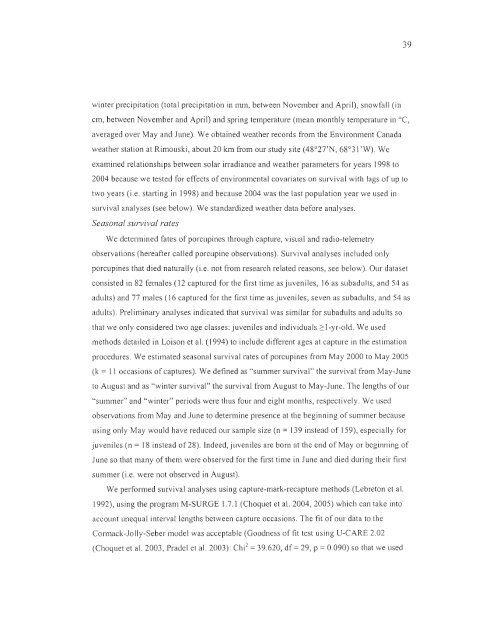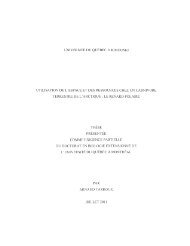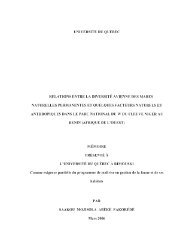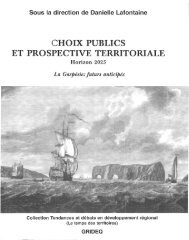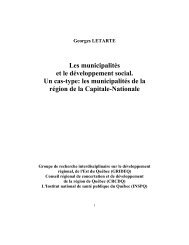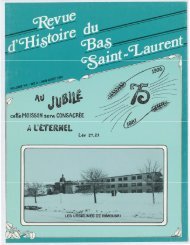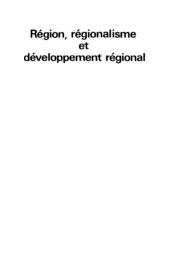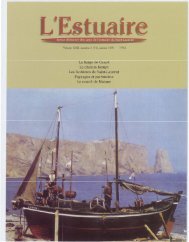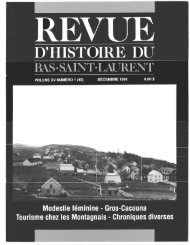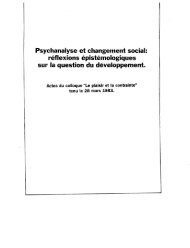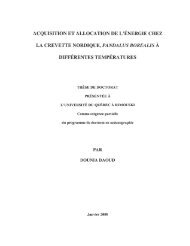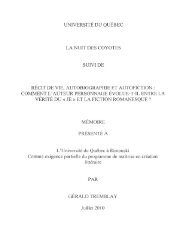influence du climat et de la prédation sur l'utilisation de l'habitat et la ...
influence du climat et de la prédation sur l'utilisation de l'habitat et la ...
influence du climat et de la prédation sur l'utilisation de l'habitat et la ...
You also want an ePaper? Increase the reach of your titles
YUMPU automatically turns print PDFs into web optimized ePapers that Google loves.
39<br />
winter precipitation (total precipitation in mm, b<strong>et</strong>ween November and April), snowfall (in<br />
cm, b<strong>et</strong>ween November and April) and spring temperature (mean monthly temperature in oC,<br />
averaged over May and June). We obtained weather records from the Environment Canada<br />
weather station at Rimouski, about 20 km from our study site (48°27'N, 68°31 'W). We<br />
examined re<strong>la</strong>tionships b<strong>et</strong>ween so<strong>la</strong>r irradiance and weather param<strong>et</strong>ers for years 1998 to<br />
2004 because we tested for effects of environmental covariates on <strong>sur</strong>vival with <strong>la</strong>gs of up to<br />
two years (i.e. stalting in 1998) and because 2004 was the <strong>la</strong>st popu<strong>la</strong>tion year we used in<br />
<strong>sur</strong>vival analyses (see below). We standardized weather data before analyses.<br />
Seasona! <strong>sur</strong>vival rates<br />
We d<strong>et</strong>ennined fates of porcupines through capture, visual and radio-telem<strong>et</strong>ry<br />
observations (hereafter called porcupine observations). Survival analyses inclu<strong>de</strong>d only<br />
porcupines that died naturally (i .e. not from research re<strong>la</strong>ted reasons, see below). Our datas<strong>et</strong><br />
consisted in 82 females (12 captured for the first time as juveniles, 16 as suba<strong>du</strong>lts, and 54 as<br />
a<strong>du</strong>lts) and 77 males (16 captured for the first time as juveniles, seven as suba<strong>du</strong>lts, and 54 as<br />
a<strong>du</strong>lts). Preliminary analyses indicated that <strong>sur</strong>vival was simi<strong>la</strong>r for suba<strong>du</strong>lts and a<strong>du</strong>lts so<br />
that we only consi<strong>de</strong>red two age c<strong>la</strong>sses: juveniles and indivi<strong>du</strong>als 2: l-yr-old. We used<br />
m<strong>et</strong>hods d<strong>et</strong>ailed in Loison <strong>et</strong> al. (1994) to inclu<strong>de</strong> different ages at capture in the estimation<br />
proce<strong>du</strong>res. We estimated seasonal <strong>sur</strong>vival rates of porcupines from May 2000 to May 2005<br />
(k = Il occasions of captures). We <strong>de</strong>fined as "summer <strong>sur</strong>vival" the <strong>sur</strong>vival from May-June<br />
to August and as "winter <strong>sur</strong>vival" the <strong>sur</strong>vival from August to May-June. The lengths of our<br />
"summer" and "winter" periods were thus four and eight months, respectively. We used<br />
observations from May and June to d<strong>et</strong>ermine presence at the beginning of summer because<br />
using only May would have re<strong>du</strong>ced our sample size (n = 139 instead of 159), especially for<br />
juveniles (n = 18 instead of 28). ln<strong>de</strong>ed, juveniles are born at the end of Mayor beginning of<br />
June so that many of them were observed for the first time in June and died <strong>du</strong>ring their first<br />
summer (i.e. were not observed in August).<br />
We performed <strong>sur</strong>vival analyses using capture-mark-recapture m<strong>et</strong>hods (Lebr<strong>et</strong>on <strong>et</strong> al.<br />
1992), using the program M-SURGE 1.7.1 (Choqu<strong>et</strong> <strong>et</strong> al. 2004, 2005) which can take into<br />
account unequal interval lengths b<strong>et</strong>ween capture occasions. The fit of our data to the<br />
Cormack-Jolly-Seber mo<strong>de</strong>l was acceptable (Goodness of fit test using U-CARE 2.02<br />
(Choqu<strong>et</strong> <strong>et</strong> al. 2003, Pra<strong>de</strong>l <strong>et</strong> al. 2003): Chi 2 = 39.620, df= 29, P = 0.090) so that we used


